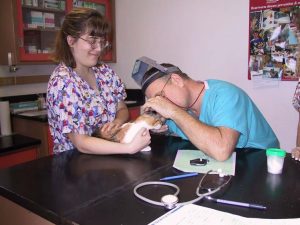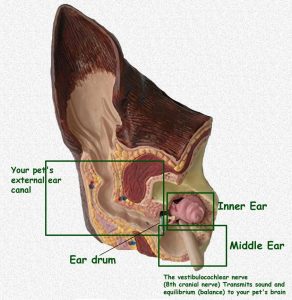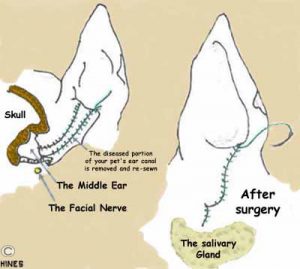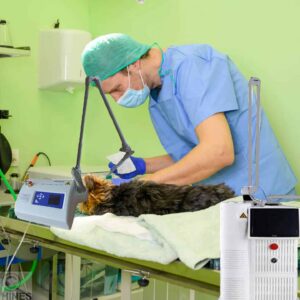Ear Surgery In Your Dog Or Cat – The Only Permanent Cure For Chronic Otitis
Ron Hines DVM PhD
This article does not deal with cosmetic ear surgery. Cosmetic ear surgery or ear cropping is performed strictly to satisfy the vanity of the dog’s owner. I try to talk dog owners out of that – and tail-docking, whenever I can.
This article discusses legitimate surgery that usually cures stubborn ear infections that no longer respond to the medications your veterinarian has to offer. The surgery is radical, but I find no greater joy that to see pets that have suffered so long finally be free of pain. It is one of the most satisfying surgical procedures a veterinarian like me can perform.
Two other articles in this series discuss the various causes of ear infections and how to control them. They are quite similar – just written at different times. Read them here and here. Infections that reoccur over and over again all result in a similar situation – a disease that no longer respond to antibiotics, with permanent changes in the ear canal. Another article discusses “blood blisters” (a type of hematoma or blood pocket) that sometimes form when your dog shakes it head violently due to ear irritation. Read that article here.
Most veterinarians probably postpone this operation longer than they should. The usual sequence of events is that we try every form of ear medication sold and concoct a few of our own before we inform the owners that surgery is the best answer.
The ear is an ideal place for recurrent infections. Floppy-eared dogs or cats bred to have folded down ears have very poor air circulation within their ear canal to begin with. The ear canals of dogs (and cats) naturally slope upward (uphill) from the ear drum – so they do not readily drain. The two canals are lined with a delicate skin-like membrane which, when inflamed for any reason, secretes moist exudates that are ideal for bacterial and mold growth. In normal ears, sebaceous glands secret a translucent, protective ear wax. In ears that have long been infected, apocrine tubular glands lining your dog or cat’s ear canals become more numerous and secrete a sticky brown material, rich in nutrients, ideal for bacterial and fungus growth. Long-term Infections also cause scaring, which narrows the canal and obstructs drainage and air circulation even more. These changes – once they occur – are irreversible.
It is unclear to me why so few dogs undergo total canal surgery, since the results are usually excellent. Cost is probably the greatest factor. There are a number of surgical techniques. The less drastic ones spare varying amounts of ear canal tissue. These include lateral or vertical ear canal resection, Zepp otoplasty and some forms of ventral bullar osteotomy. (read here) In my experience, the less radical procedures are ineffective in more than fifty percent of the cases. (read here)
Total ear canal ablation is usually successful, while less extensive types of ear surgery often fail. The secret of success is in veterinarians choosing their surgical candidates wisely. Canal ablation needs to be combined with middle ear drainage and curettage (scraping) if it is to succeed in curing deep infections. In deep ear canal disease, infections have passed beyond your pet’s eardrum and affected their middle and inner ear. These pets have specific signs related to the deeper infection. They often hold their heads cocked with the affected ear down. They may circle toward the affected ear, and the eyelids and lip on that side may be droopy. They often walk cautiously and have problems keeping their balance. X-rays of the head sometimes show the extent of damage to the bones that surround their ear canal.
Once your veterinarian decides which procedure to use, they will often begin the dog or cat on 10–14 days of pre-surgical antibiotics. It is helpful to have a bacterial culture taken from the ear to help choose the best antibiotic possible. Every veterinarian has their own unique techniques and procedures they find most successful for them. But when I do this surgery (with the pet asleep), I shave the ear and then flush it with detergents, iodophors and antibiotics. I use a blue surgical marker to delineate the area that is to be removed. Because the ear canal is very vascular (bloody) I like to perform this surgery with an electrosurgical unit. A T-shaped incision is made over the ear canal and all diseased tissue and ear canal cartilage is carefully removed (see diagram). No diseased tissue must remain.
One must take special care to locate and avoid the facial nerve, which runs just below your pet’s ear canal. This nerve is responsible for tear secretions in the eye, as well as eyelid and lip function on that side of the face. So stretching or cutting this nerve will lead to complications. One also must isolate and avoid nicking the parotid salivary gland that surrounds the base of the pet’s ear. I, personally, do not worry that much about hearing loss. Most of the dogs and cats that need this surgery already have quite extensive hearing loss that they have adapted to.
After the surgery, pets need powerful pain control medications for several days. NSAIDs, like carprofen, and drugs like tramadol are insufficient. (read here) Many veterinarians now send the pets home with fentanyl narcotic patches. You can read about many of the pain relieving medications available to your pet here.
I keep patients at the hospital until they are eating well and up and around. During this period, they receive injectable broad-spectrum antibiotics. I send them home on oral antibiotics for an additional two to three weeks.
Occasional complications are to be expected after any surgery. The older the dog is when this surgery is performed, the slower healing will occur and the greater the risk of complications. Salivary gland leakage into the surgical field occurs occasionally. These usually resolve themselves with time. Damage to the facial nerve, either due to the ear infection or stretching of the nerve during surgery, usually resolves during the next few weeks. If it should remain, it may be necessary to apply eye drops to the affected eye on a routine basis indefinitely to prevent dry eye.
Is There A Newer Option?
Yes
Until recently, veterinarians relied on electrocautery units to perform surgery in areas where there was abundant blood supply, such as your dog’s ear. Electrocautery was quite successful in sealing bleeding blood vessels, but it caused some damage to adjoining tissue and also some swelling that makes the pet’s ear canal even narrower. C02 lasers have been used in human medicine for many years. Initially, they were primarily used by plastic surgeons to resurface facial skin, and perform other delicate cosmetic surgery. But the price of these lasers put them beyond the budgets of most veterinarians. C02 lasers utilize certain waves of light to vaporize tissue more precisely than electrocautery that utilizes heat generated by an electric arc. The older time cauteries were not much more than medical soldering irons.
CO2 lasers, besides vaporizing unwanted tissue, seal off small blood vessels, preventing excessive hemorrhage and remove the need for your veterinarian to tie off the many small blood vessels of the ear canal one by one. I attended a seminar at which a Houston, TX veterinarian reported that he and his colleagues had managed to avoid ear ablation, a procedure which eliminates ear pain, but minimizes or eliminates hearing, using their C02 laser. A procedure referred to as “resculpturing” the ear. He did mention that several laser surgeries might be required. He also said that the end results were not always successful, but if they were not, one could always perform an ear ablation later. What was also mentioned was that many dogs in which this procedure was not successful were found to have middle ear infection that were not recognized earlier. The number mentioned was 20%. Another thing mentioned was that the majority of dogs that develop ear problems have atopic dermatitis.
You are on the Vetspace animal health website
Visiting the products that you see displayed on this website help pay the cost of keeping these articles on the Internet.




